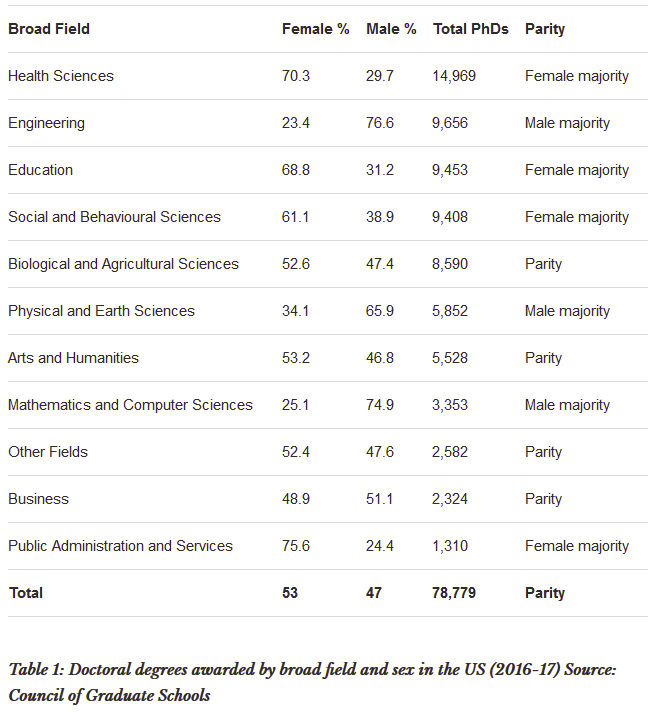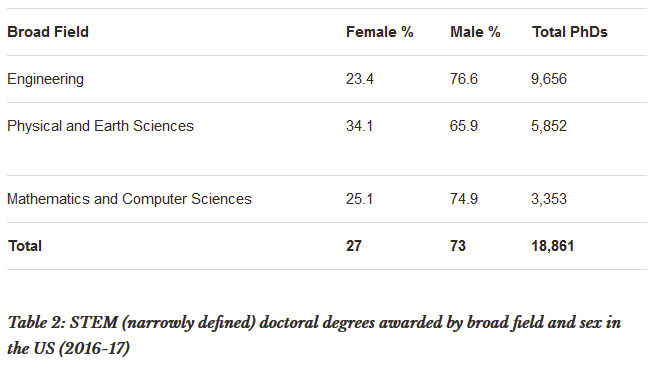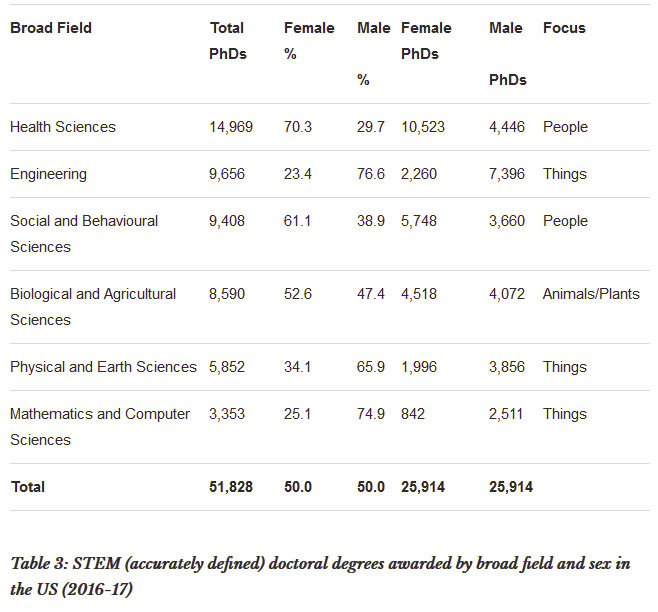Victory for Women in US PhD Awards Nine Years Running
In the US, women have earned more PhDs than men for the past nine years. The most recent figures are shown in Table 1. Based on the data, I have added a column labelled "Parity." A broad field is classified as having parity if the female percentage figure is in the range 40-60. If the female percentage figure is greater than 60 it is classified as female majority. If the male percentage figure is greater than 60 it is classified as male majority.
Of the 11 broad fields, four have parity, four are female majority and three are male majority.
I found these figures in an article published by the World Economic Forum. Read in a straightforward way, they show women are doing better than men in terms of acquiring PhDs.
Snatching Continuing Defeat from the Statistics of Victory
Good news for women one might think. The fact that women are getting more PhDs than men crushes the old-time sexist stereotypes that women are "incapable of reason" and that education is "wasted" on females. A key requirement for a PhD is to make an "original contribution to knowledge." More women than men now make "original contributions to knowledge" in America. This is a truly significant development.
Indeed, the data shows girls at school and women at university have been doing better than males for decades now. A fair and reasonable society gives all its talent, not just half of it, a shot at the highest levels of education. The numbers show the US has achieved this positive outcome for nine years running.
These figures could have been used to write a positive story but instead the WEF article said:
More than half (53 percent) of the 79,000 doctoral degrees handed out in the United States last year went to women-a record high.Rather than celebrate the overall "record high," the (female) author of the WEF article chose to reprise some well-worn complaints about women in STEM. The emphatic female majorities were skated over:
But as the ... chart [reproduced in Table 1 above] shows, men still earned the majority of PhDs in most STEM (science, technology, engineering and maths) subjects.
In some fields, as many as three-quarters of the PhDs awarded went to women, including public administration and services (75.6 percent), health sciences (70.3 percent) and education (68.8 percent). Women were also ahead of men in arts and humanities, as well as social and behavioral sciences.None of these figures were considered "problems" in terms of gender parity by the author of the WEF article. No concern was expressed about the underrepresentation of men in any broad field of science. So, surprise, surprise, STEM (as usual) is the problem:
However, men still dominated in the fields of engineering (76.6 percent), mathematics and computer sciences (74.9 percent) and physical and earth sciences (65.9 percent), which suggests that more needs to be done to encourage women to study STEM subjects to a higher level.There was no mention of any need to encourage more men to study health or social sciences at a higher level. Representation of men in four broad fields at a level below parity is apparently not a problem.
Dubious Definitions of Science and Technology
STEM stands for Science, Technology, Engineering and Mathematics. However, when people speak of "STEM" it seems they understand the "S" in STEM to refer to "hard" sciences like physics and chemistry but not "soft" sciences like psychology and neuroscience. The "T" in STEM seems to refer to computers, cars, oil refineries and aircraft but not to X-ray machines and fMRI scanners used in health, carbon-dating technology used in archaeology and vast corpuses of textual data processed on computers used in linguistics and political science.
The "E" refers to engineering. The "M" refers to mathematics. I have no complaint about the "E" and "M," my argument focuses on the narrow definitions of the "S" and "T" in STEM.
Some technologies are arbitrarily excluded (lies) and some sciences are arbitrarily excluded (damned lies) from what counts as STEM. These arbitrary exclusions result in a warped and gerrymandered definition. Narrowly defined, the aggregate figures for "STEM" are as shown in Table 2:
On this definition that excludes health sciences, social and behavioural sciences and biological and agricultural sciences from counting as science, one can present a "problem" in that women are "only" 27 percent of STEM PhDs thus defined.
Given the definition, the statistic is valid but I have yet to see a compelling argument that explains why having only 27 percent women in STEM PhDs is a "problem" and having "only" 24.4 percent men in public administration and services PhDs and "only" 29.7 percent of men in health sciences PhDs is not.
If one adopts a more accurate definition of the "S" in STEM, the "problem" of female underrepresentation disappears. This is done by not excluding health sciences, social and behavioural sciences and biological and agricultural sciences from STEM, on the grounds that these "broad fields" contain sciences as their names clearly indicate.
Further, these fields develop and use a lot of technology. How is a dentist's drill not technology? How is a linguistics or political science "big data" corpus not technology? How is an X-ray machine used in radiography or the heart and breathing monitors used by nurses in an intensive care unit not technology? How is an fMRI scanner used in a neuroscience experiment not technology? How is a whiff of oxytoxin used in a psychology experiment not technology? How is examining and modifying DNA in biology and agricultural science not technology?
When STEM is accurately defined, using broader and more realistic definitions of science and technology, it turns out that women earn 50 percent of STEM PhDs as shown in Table 3:
The emphatic male majorities in "hard" sciences are balanced by emphatic female majorities in the health sciences and the "soft" social and behavioural sciences. So, if parity of women in STEM PhDs is a mission, the data in Table 3 shows this mission is accomplished.
This is not to suggest all is right in the world for women. Things remain pretty bleak in many non-Western countries and challenges regarding female promotion to senior levels remain, even in the West. It is merely to suggest, as the positive psychologists do, that one should count one's blessings. A win is a win. The US PhD statistics are a major win for women in the second decade of the twenty-first century.
People and Things
As I did in Table 1 I have added an extra classification column (Focus) to Table 3. I have made a broad judgement that STEM narrowly defined (i.e. Engineering, Physical and Earth Sciences, Mathematics and Computer Sciences) is focussed mostly on things. Two of the three broad fields excluded from the narrow definition of STEM are more focussed on people (Health Sciences, Social and Behavioural Sciences).
The third broad field excluded from STEM narrowly defined is Biological and Agricultural Sciences which I judge to be more about animals and plants than people or things. Animals and plants are like people in that they are living but, while animate, they are not people. Even so, they are more like people than rocks, planets, machines and stars. So I judge them to be a "halfway house" between the inanimate things that are (mostly) studied in the so-called "hard" sciences and the people that are studied in the health sciences and the so-called "soft" social and behavioural sciences. As the data shows, this "halfway house" turns out to be the most balanced broad field in terms of male and female participation rates in Table 3.
In summary, Table 3 would appear to confirm that males and females have roughly equal interests in animals and plants (living things). Males as a group are less into people and more into things. Females as a group tend to be more interested in people and less interested in things. This is hardly a revelation. Psychologists have known about this "people/things" asymmetry between the sexes for decades.
Now this is not to say that a particular woman is "incapable" of studying things or that women "can't code" or whatever. Nor it is to say a particular man or woman cannot be interested in both people and things. Nor is it even to claim engineering is entirely about things not people. It is not. The people/things preference exists on a spectrum. It is not a simplistic "either/or" binary. What the figures show is that bright women as a group tend to be somewhat more interested in so-called "soft" sciences and somewhat less interested in so-called "hard" sciences. The entire hard/soft science distinction is hopelessly dated in any case. Indeed, one might be inclined to think this anachronistic distinction "phallocentric" but such language is not analytically useful. There is no great problem here: just re-confirmation of a well-known psychological finding about people and things.
The See-Saw Principle
If we assume that there is overall parity between the numbers of men and women and that roughly the same numbers are available to enter any broad field of PhD study, mathematically, you cannot have emphatic majorities of women in some sectors (e.g. health science and education) without emphatic minorities of women in other sectors (e.g. engineering and computing). Call this the see-saw principle.
If we let a 100 kids into a park (53 girls and 47 boys) with 11 see-saws in it and the girls stampede towards the 4 see-saws they think are preferable for whatever reason, and 4 see-saws have roughly equal numbers of boys and girls on them, we should not be unduly perturbed when we come across 3 see-saws with relatively few girls on them because we have simply run out of girls to put on see-saws. The majority freely chose to play on the 8 other see-saws based on their preferences and interests.
We do not need to argue there is something malevolent about the 3 see-saws with mostly boys compared to the 4 see-saws with mostly girls, if we have data that shows asymmetries in preferences for certain kinds of see-saw between the sexes. We have such data. If we liken the broad fields of PhD study to see-saws, we see that the see-saws involving people are more attractive to females: those involving things are more attractive to males. Some of the see-saws (Biological and Agricultural Sciences, Business, Arts and Humanities and Other Fields) are equally attractive to both males and females.
Sexism as an Explanation for Low Numbers of Women in STEM
From what I can tell, the complaints about women in STEM, are, to a large extent, based on a flawed definition of the "S" and "T " in STEM (too narrow), flawed arithmetic (ignorance of the see-saw principle), and ignorance about psychology (the well-known "people/things" asymmetry). These complaints seem to be fuelled by anecdotes and surveys of sexism in engineering and the "hard" sciences. However, there are anecdotes and surveys of sexism in the health sciences, the law, the arts (#MeToo) and the humanities (Searle's girls) too.
It strikes me as bizarre to suggest sexism is holding women down dramatically in some buildings of the contemporary university and not holding them down at all in adjacent buildings where they achieve emphatic majorities in terms of completing PhDs. The same HR policies regarding sexism, discrimination, harassment and so on apply everywhere on campus and in broader society. Numerous academics of global renown have been defenestrated for sexist acts (harassing and having affairs with female graduate students in the case of the philosopher, John Searle) and utterances (saying females are more likely to cry than men and are a distraction in a lab in the case of Tim Hunt, a 2001 Nobel laureate).
So, from the above we can conclude that sexism is not a particularly convincing explanation for the relative lack of women in STEM narrowly defined at university. I don't doubt sexism explains some cases of women bailing out of engineering. I don't doubt sexism explains some cases of women bailing out of medicine and law either. Everybody will run into a bad boss or a toxic colleague at work sooner or later. However, far more plausible explanations for the relatively low numbers of women in STEM narrowly conceived are the female preference for working with people rather than things and the see-saw principle, the simple fact that, given overall parity, it is statistically impossible for women to be an emphatic majority in one broad field without being an emphatic minority in another.
I fully support efforts to get more women into fields like AI, robotics, software development and chemical engineering. However, there is no evidence that nurses and primary school teachers are secretly frustrated roboticists or chemical engineers who deep down really want to work with things not people. Furthermore, getting more women into such fields entails getting fewer women into fields like nursing, education, medicine, and psychology. There is no escaping the see-saw: unless, of course, men become an emphatic minority at university.
Sean Welsh is a PhD candidate in the Department of Philosophy at the University of Canterbury in New Zealand, and the author of Ethics and Security Automata, a research monograph on machine ethics. Prior to embarking on his PhD he worked as a software developer for 17 years. You can follow him on Twitter @sean_welsh77







Comment: See also: Studies show that asymmetries in the workplace do not indicate gender discrimination